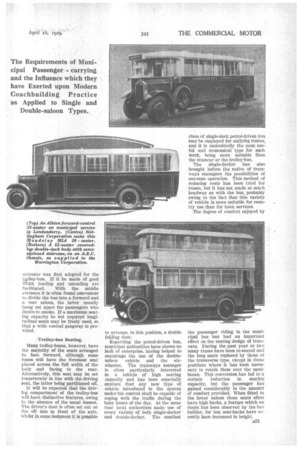BUS-BODY FEATURES
Page 136

Page 137

If you've noticed an error in this article please click here to report it so we can fix it.
favoured by Municipalities
glITE municipally owned bus has
an important bearing on the general progress and development of the bus-building industry. Local authorities have owned buses for a long time and during recent years have been buyers of considerable numbers of vehicles. These buses are not usually acquired until very careful comparisons and tests have been made, and much time is often spent in inspecting one or more types of vehicle running under service conditions.
The general manager of the passenger-transport undertaking, or other official concerned, usually pre pares a full specification of the bodywork required, as well as the design of the body itself, and those builders whose tenders are accepted know that only the best class of work will pass the inspections made both during the course of construction and when the vehicle is completed.
The municipal authority, like other large bus-owning concerns, is to employ fully qualified officials who are competent to judge the quality of a vehicle from all points of view, a matter which must tend to maintain a high standard of merit.
The number of municipal buses will, it is thought, be increased materially in the course of the next
1)50 few years, especially in those instances where trams are now in use, in view of the cost of permanentway repairs, which does not bear the same relation to receipts as it did in the pre-war period. As an alternative to the use of petrol-driven buses in place of tramcars, a number of local authorities has made an excellent compromise by converting their systems for operation by trolley-buses, or by employing trolley-buses for route extensions.
The capital expenditure incurred for a fleet of trolley-buses is higher than that for the same number of motorbuses, but there is the advantage that some of the existing equipment can be used, whilst the consumption of power from a generat ing station is usually giving employment to local workers. The trolley:. bus can only be run where there are overhead wires, but, unlike the tramcar, it can be steered to the side of the road so that passengers may board or alight at the footpath. Now that the trolley-bus is made as a large-capacity six-wheeled vehicle with two saloons it becomes a difficult matter to justify any further capital expenditure in the laying down of tramways.
• Trolley-bus Bodywork.
Apart from the question as to which is the best form of traction, the bodywork of the trolley-bus is of particular interest. The chassis on which it is mounted offers plenty of scope for the body designer, because most of the space usually taken up by the petrol engine can be utilized for seating. Although it is possible to build a 40-seater trolleybus within an overall length of 25 ft., the ample length of chassis available is used rather to provide a large main entrance in the middle of the near side of the vehicle.
It is claimed that this style of entrance was first adopted for the Willey-bus. If it be made of good Width loading and unloading are facilitated. With the middle entrance it is often found convenient to divide the bus into a forward and a rear saloon, the latter usually being set apart for passengers who desire to smoke. If a maximum seating capacity be not required longitudinal seats may be freely used, so that a wide central gang-way is provided.
Trolley-bus Seating.
Many trolley-buses, however, have the majority of the seats arranged to face forward, although some buses will have the foremost seat placed across the full width of the body and facing to the rear. Alternatively, this seat may be set transversely in line with the driving Seat, the latter being partitioned off.
It will be expected that the driving compartment of the trolley-bus will have distinctive features, owing to the absence of the usual bonnet. The driver's door is often set out on the off side in front of the axle, whilst in some instances it is possible
to arrange, in this position, a double folding d oor Regarding the petrol-driven bus, municipal authorities have shown no lack of enterprise, having helped to encourage the use of the doublesaloon vehicle and the sixwheeler. The tramways manager is often particularly interested in a vehicle of high seating capacity and has been especially anxious that any new type of vehicle introduced in the system under his control shall be capable of coping with the traffic during the busy hours of the clay. At the same time local authorities make use of every variety a both single-decker and double-decker. The smallest
class of single-deck petrol-driven bus may be employed for outlying routes, and it is undoubtedly the most useful and economical type for such work, being more suitable than the tramcar or the trolley-bus.
The single-decker has also brought before the notice of tramways managers the possibilities of one-man operation. This method of reducing costs has been tried for trains, but it has not made so much headway as with the bus, probably owing to the fact that this variety of vehicle is more suitable for country use than for town services.
The degree of comfort enjoyed by the passenger riding in the municipal bus has had an important effect on the seating design of tramcars. During the past year or two many trams have been re-seated and the long seats replaced by those of the transverse type, except in those positions where it has been necessary to retain them over the sandboxes. This conversion has led to a certain reduction in seating capacity, but the passenger has gained considerably in the amount of comfort provided. When fitted in the lower saloon these seats often have high backs, a feature which no doubt has been observed by the bus builder, for bus seat-backs have recently been increased in height.








































































































































































































